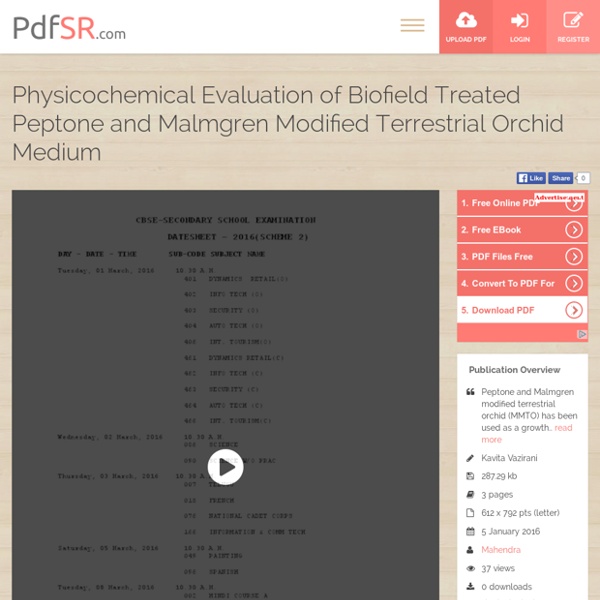



Hanks Balanced Salt Solution - An Evaluation of Biofield Treatment Comparative Physicochemical Evaluation of Biofield Treated Phosphate Buffer Saline and Hanks Balanced Salt Medium Phosphate buffer saline (PBS) has numerous biological and pharmaceutical applications. Hank buffer salt (HBS) has been used as a medium for tissue culture applications. Antimycobacterial Susceptibility Testing of Anti-tubercular Drugs Title: An Impact of Biofield Treatment: Antimycobacterial Susceptibility Potential Using BACTEC 460/MGIT-TB System Select license: Creative Commons Attributions-NonCommercial-ShareAlike Updated: November 19th, 2016 Abstract: The aim was to evaluate the impact of biofield treatment modality on mycobacterial strains in relation to antimycobacterials susceptibility.
Biofield Treatment Modality on Mycobacterial Strains 0WordPress0CiteULike0 New The aim was to evaluate the impact of biofield treatment modality on mycobacterial strains in relation to antimycobacterials susceptibility. Mycobacterial sensitivity was analysed using 12 B BACTEC vials on the BACTEC 460 TB machine in 39 lab isolates (sputum samples) from stored stock cultures. Two American Type Culture Collection (ATCC) strains were also used to assess the minimum inhibitory concentration (MIC) of antimicrobials (Mycobacterium smegmatis 14468 and Mycobacterium tuberculosis 25177). Rifampicin, ethambutol and streptomycin in treated samples showed increased susceptibility as 3.33%, 3.33% and 400.6%, respectively, as compared to control in extensive drug resistance (XDR) strains. Your session has expired but don’t worry, your message has been saved.Please log in and we’ll bring you back to this page. Your evaluation is of great value to our authors and readers. Review When you're done, click "publish" Only blue fields are mandatory. Description
Study of XRD & MDR Strains of Mycobacterium Description The aim was to evaluate the impact of biofield treatment modality on mycobacterial strains in relation to antimycobacterials susceptibility. Mycobacterial sensitivity was analysed using 12 B BACTEC vials on the BACTEC 460 TB machine in 39 lab isolates (sputum samples) from stored stock cultures. Two American Type Culture Collection (ATCC) strains were also used to assess the minimum inhibitory concentration (MIC) of antimicrobials (Mycobacterium smegmatis 14468 and Mycobacterium tuberculosis 25177). Citation Information Mahendra Kumar Trivedi.
Human Energy Treatment for Increasing Tomato Yield Abstract: Recent studies report the effect of biofield treatment on changes in structural characteristics of organic and inorganic matter, on cancer cells in vitro and on overall plant development. This study tested the impact of the same treatment applied to lettuce and tomato seeds and transplants (Lactuca sativa var. capitata and Lycopersiconesculentum var. Keywords: Crop development; Biofield treatment; Fertilizer and Organic; Lettuce; Tomato Information-containing biofield energies have been postulated to be associated with living organisms and to affect their self-regulation processes (Rubik, 2002). Although science has earlier tested such energies in plants, in the above-mentioned studies the scientific facts to support such claimsare for the first time seeingreproducible and significant results in experimental observations. Seeds were treated and allowed to germinate until ready to be transplanted. Treatment: Crop Parameters: Needbase fertilizer and pesticide applications: Lettuce:
Soybean Seed Treatment for Increasing the Productivity Abstract Soybean production in Iowa USA is among the most productive for raínfed regions in the world. Despite generally having excellent soils, growing season temperatures and rainfall, soybean yields are decreased by weed interference and inadequate available soil water at key stages of crop development. A field study was conducted at two locations in lowa in 2012 to determine if seed-applied fungicide or biofield treatments influenced weed community, soil volumetric water concentration and soybean yield and quality. Keywords: Soybean, biofield energy treatment, prickly sida, tall waterhemp, yellow foxtail, yield, seed oil, seed protein, soil volumetric water concentration Download the original manuscript
Evaluation of Phenotype and Genotype of Enterobacter Aerogenes Abstract Enterobacter aerogenes (E. aerogenes) has been commonly described as a versatile opportunistic pathogen in hospital infections. The aim of the present work was to evaluate the impact of biofield treatment on E. aerogenes for its phenotypic and genotypic characteristics. E. aerogenes bearing ATCC 13048 (American Type Culture Collection) was procured from Bangalore Genei, in sealed pack and divided into control and treated groups. Treated group was subjected to Mr. Trivedi’s biofield treatment and analyzed for antimicrobial susceptibility, minimum inhibitory concentration (MIC), biochemical reactions, and biotype using automated MicroScan Walk-Away® system. Keywords: Enterobacter aerogenes, Biofield treatment; Phenotyping, Polymorphism; RAPD; 16S rDNA analysis Introduction Enterobacter aerogenes (E. aerogenes) is a common organism of most of the hospital-acquired infections. Biofield is the name given to the electromagnetic field that permeates and surrounds living organisms [7].
Study of Antimicrobial susceptibility of S. Marcescens Abstract Serratia marcescens (S. marcescens) is Gram-negative bacterium, associated with hospital-acquired infections (HAIs), especially urinary tract and wound infections. The present study was aimed to evaluate the impact of biofield treatment on phenotyping and genotyping characteristics such as antimicrobial susceptibility, biochemical reactions, biotype, DNA polymorphism, and phylogenetic relationship of S. marcescens (ATCC 13880). The lyophilized cells of S. marcescens were divided into three groups (G1, G2, and G3). Control group (G1) and treated groups (G2 and G3) of S. marcescens cells assessed with respect to antimicrobial susceptibility, and biochemical reactions. In addition to that, samples from different groups of S. marcescens were evaluated for DNA polymorphism by Random Amplified Polymorphic DNA (RAPD), and 16S rDNA sequencing in order to establish the phylogenetic relationship of S. marcescens with different bacterial species. Introduction Materials and Methods Results